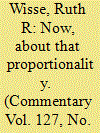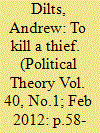|
|
|
Sort Order |
|
|
|
Items / Page
|
|
|
|
|
|
|
| Srl | Item |
| 1 |
ID:
085961


|
|
|
|
|
| Publication |
2009.
|
| Summary/Abstract |
The charge that Israel's incursion into Gaza led to a "disproportionate" use of force against Palestinians, issued by the likes of former President Jimmy Carter and UN Secretary-General Ban Ki-moon, met with surprising rhetorical resistance in unexpected quarters (on this continent, at least) in the first few weeks after Israel began its operation at the end of December. "Anyone who knows anything about the Middle East knows that proportionality is madness," wrote Richard Cohen of the Washington Post, who is better known as a critic than as a defender of Israel. "These calls for proportionality rankle. They fall on my ears not as genteel expressions of fairness, some ditsy Marquess of Queensbury idea of war, but as ugly sentiments pregnant with antipathy toward the only state in the Middle East that is a democracy."
|
|
|
|
|
|
|
|
|
|
|
|
|
|
|
|
| 2 |
ID:
105164


|
|
|
|
|
| Publication |
2011.
|
| Summary/Abstract |
Protocol I, Additional to the Geneva Conventions, in Article 57, mandates the rule of proportionality governing military attacks. The literature on international humanitarian law, however, reflects a widely-held view that this mandate is often ignored. Motivated by that view, this paper discusses three strategies, which, by appealing to ubiquitous social values, can encourage respect for and, in turn, compliance with the proportionality rule. These strategies are: first, interpreting a proportional attack as one which requires a rational and equitable balance, in cost-benefit terms, of the conflicting military and humanitarian interests, respectively, of the attacking and the attacked Parties (without sacrificing the desired military advantage of the former); second, requiring a planned attack to be 'objectively proportional', as measured by the preferences, quantified in statistical terms, of the 'reasonable military commander'; and, third, requiring the attacking Party to compensate victims for incidental civilian damage resulting from an attack that is not objectively proportional. Observance of the principle of proportionality depends upon voluntary compliance, induced by respect for this principle, since compliance is not compelled under current international law.
|
|
|
|
|
|
|
|
|
|
|
|
|
|
|
|
| 3 |
ID:
178920


|
|
|
|
|
| Summary/Abstract |
The term “countering violent extremism” (CVE) refers to a suite of proactive actions to counter efforts by extremists to recruit, radicalize, and mobilize followers to violence, and thus prevent extremist violence from occurring. In this article we explore the ethics of CVE. We begin with a description of CVE, framed within a discussion of the history (and issues) with counter-terrorism efforts post 9/11. We also outline the many and varied techniques and practices that the term CVE describes. We argue that the fundamental ethical tension in many of these forms of CVE is between the purported benefits of addressing the conditions that most likely contribute to recruitment and radicalization by violent extremists; and the potential risks of upstream interventions that might unfairly target communities and individuals or produce counterproductive outcomes. We then mount a defense of CVE on ethical grounds. Drawing from literature in public health ethics, we argue that violent extremism is a “social contagion” that shares relevant features with infectious diseases that motivate arguments for publicly-funded and even enforceable vaccination schedules. CVE is justified, we argue, to the degree it is necessary, effective, proportionate, minimally infringing on individual rights, and subject to public accountability. We assess these criteria and demonstrate that, while there are cases in which CVE is performed in an unjustifiable manner, the practice itself is in principle justified. This article concludes with an applied test of the model on a newly formed CVE program in the United States.
|
|
|
|
|
|
|
|
|
|
|
|
|
|
|
|
| 4 |
ID:
088701


|
|
|
| 5 |
ID:
092512


|
|
|
| 6 |
ID:
096543


|
|
|
|
|
| Publication |
2010.
|
| Summary/Abstract |
This article examines 'disproportionality'. It begins by tabling some suggestions for how greater 'proportionality' can be attained and then maintained, particularly in international security operations. A process termed 'proportionalisation' is proposed. Lessons from 'traditional' strategic studies need to be re-asserted. This is so that some of the observed limitations with recent operations can be addressed. Losing sight of key objectives is unhelpful, not least when an essential clarity of focus and leadership is required. Today, a return to some classical notions is required to address the observed strategic vacuums, together with an improved intelligence methodology being needed. This article concludes by arguing that 'disproportionality' emerges when 'high politics' become increasingly disconnected and removed from their empirical bases and 'low politics'. Greater connection needs to be engendered. Otherwise, in the absence of proportionality, strategies will increasingly fail, command and control will falter, and the desired goal of 'operational success' will elude us.
|
|
|
|
|
|
|
|
|
|
|
|
|
|
|
|
| 7 |
ID:
109941


|
|
|
|
|
| Publication |
2012.
|
| Summary/Abstract |
This essay argues that the thief, a liminal figure that haunts the boundary of political membership and the border between the law of reason and the law of beasts, drives Locke's accounts of the foundation of the commonwealth and the right to rebellion in the Second Treatise of Government. Locke's political theory is best read through punishment as a theory of subject formation, which relies on an unstable concept of proportionality to produce this liminal figure in order to secure the member as a "stable" political subject.
|
|
|
|
|
|
|
|
|
|
|
|
|
|
|
|
| 8 |
ID:
143328


|
|
|
|
|
| Summary/Abstract |
Ideally, national legislatures in democracies should be venues for peacefully resolving conflicts between opposing groups. However, they can become places of physical violence. Such violence can be an indication that countries’ legislative institutions are functioning far from the democratic ideal of being venues for peaceful conflict reconciliation. In some cases, such as Ukraine prior to the 2014 outbreak of armed conflict in the country’s east and south, violence can indicate and possibly fuel deeper political divisions. In this first global study of legislative violence, I show that brawls are more likely when legislators find it difficult to credibly commit to follow peaceful bargains. Credible commitment problems are more acute in countries with new democracies and disproportionate electoral outcomes – that is, when electoral votes for parties do not closely correspond to the legislative seats they are given. I find robust support for this argument by first examining a case study of legislative violence in the antebellum United States Senate. Pro- and anti-slavery senators became increasingly unable to maintain credible commitments in the lead-up to the 1856 caning of Senator Charles Sumner as the allocation of seats in the legislative body became more disproportional. Second, I find further support for my argument in a new global dataset of contemporary instances of violence in national legislatures. In addition, I find strong evidence that violence is more likely in legislatures with small minority governments. Despite reasonable expectations, civil wars are not associated with more legislative violence.
|
|
|
|
|
|
|
|
|
|
|
|
|
|
|
|
|
|
|
|
|